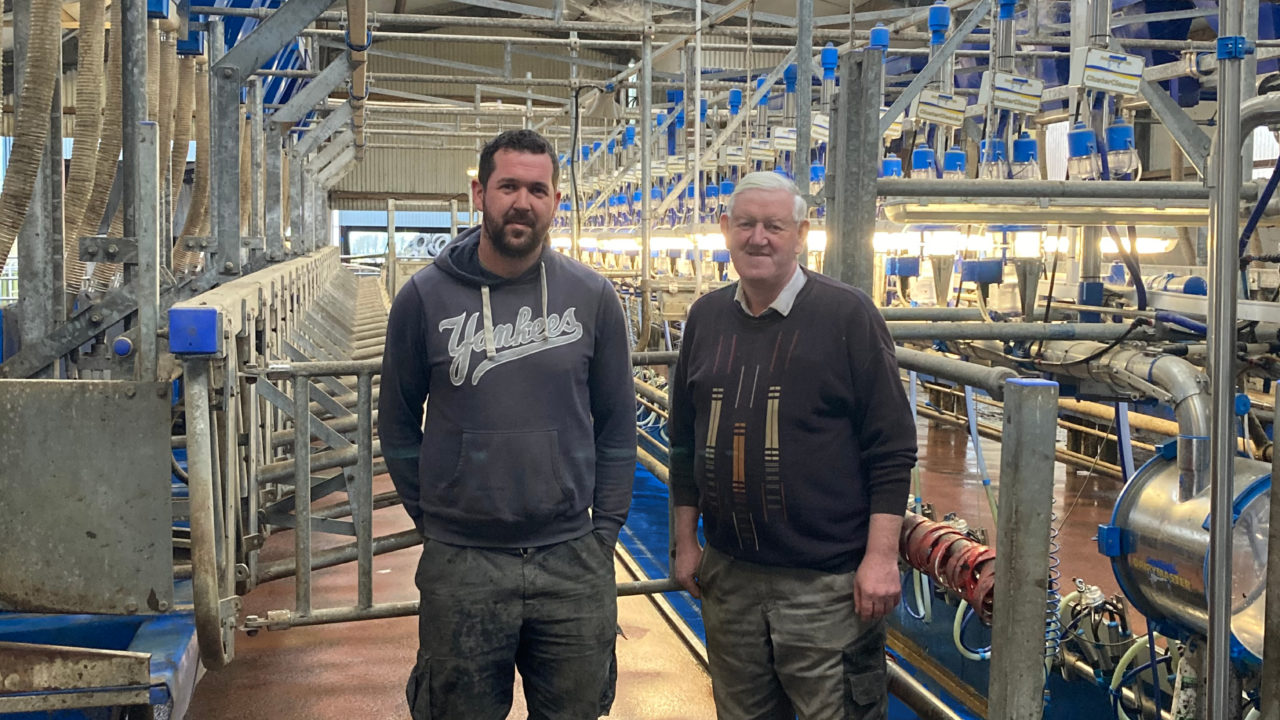John Kearney farms alongside his parents, Tom and Cathy, on their dairy farm near Rathcormack, Co. Cork.
Like many dairy farms, after quotas were removed, the Kearneys began to increase cow numbers from 140 in 2015, to 216 cows in 2021.
As the herd size increased, it became necessary to improve the overall infrastructure on the farm. The family chose to install a 24-unit Swiftflo Fast Exit Dairymaster milking parlour along with 150 cubicles.
The Kearneys are now milking their 216 cows on 107ha, in a spring-calving system, with a stocking rate of 2.44LU/ha.
The farm operates a closed herd, with no animals bought in, therefore the herd expansion is happening from within.
Currently, 87% of cows are calving in the first six-weeks of the calving season with all cows calved within 14 weeks.
Last year 5,800L/cow was sold from the farm (excluding what was fed to calves) at 4.31% fat and 3.65% protein. The cows are fed, on average, 800kg of meal along with grass and grass silage.
Infrastructure and technology improvements:
- 150 cubicle shed, which included six Dairymaster CleanSweep manure scrapers (2014);
- 24-unit Swiftflo Fast Exit milking parlour, with a feed to yield system, milk meters, ClusterCleanse, Swiftflo Commander and a drafting gate (2016);
- Dairymaster 16,500L SwiftCool milk tank (2016);
- Dairymaster MooMonitor+ system (2017);
- 56-cubicle shed with two scraper passages and six calving pens (2019).
Labour saving on the dairy farm
Like most Irish dairy farms it is a family-run farm, with reducing labour costs being key to the enterprise. This has involved reducing the amount of time required to carry out jobs and the number of people needed.
“The new parlour, bulk tank and MooMonitor+ has been a major time saver for the farm. In our old parlour, it was taking two and half hours to milk 150 cows; we are now milking 216 and it takes an hour and 20,” John explained.
“The fast exit is a big thing, a cow can’t stop halfway and put her head into a trough. I’m not sure how long it would take for 24 to exit a normal parlour, but all that time adds up.
“Before we installed the MooMonitor+ system, it took three people to milk and detect heats, now one person can do it. We are 100% AI [artificial insemination], we don’t use tail paint and have put our trust solely in the MooMonitor+ system and it hasn’t failed us yet.”

He continued: “We have found it to be ‘spot-on’ every time. It also picks up cows that are not cycling, where before, it might take a few weeks before you would notice that they weren’t cycling.
“We monitor heat six weeks before breeding and any cow that doesn’t cycle is drafted and checked. Last year we drafted 17 cows and they all were either dirty or had a cyst.
“We also have the text alert on the milk tank and there have been times where you forget to turn it on or there was a power cut and you get a text alert.
“It’s the extra peace of mind compared to our old tank, there is also a major energy saving. Before I have the wash finished the bulk tank has turned off, where our old tank was running for up to two hours after milking,” John continued.
“When we installed the 150 cubicles we also installed six new Dairymaster CleanSweep manure scrapers. We had old Dairymaster scrapers that were 40-years old and still working, so why would we move away from them?
“We put the old ones in the shed; we had to scrape with the tractor so they are still working 40 plus years later on the farm.”
Another major benefit that John noticed, was that it gave him peace of mind when milking cows that are on antibiotics.
“The parlour talks to you and gives you an alert if there’s an antibiotic cow or a slow cow comes in. We know then that a slow cow is in position five and we put a cluster on her as soon as it is free,” he said.
“You actually can’t put a cluster on an antibiotic cow without diverting the milk, which means that if someone else is milking you know there will not be a mistake,” John added.
Working together
Because the Kearneys have Dairymaster products, the system can all be linked, meaning the technology on the dairy farm requires little input from the Kearneys.
“The fact that all the system works together is great. You get an alert that a cow is in heat and when she’s milking you might notice that her production is down compared to normal, so you might jump up to check if there is any signs of bulling,” John said.
“But I know once I let the cows out from the parlour, that cow will be waiting in the pen for the AI man to come.
“The technology is doing the work for you. Before, Mam would have had to stand and watch the cows, whereas now there is no need for that.
“You might get an alert for a sick cow and you would notice she is slightly off, but without that alert, you wouldn’t. You are picking up sick cows quicker which means the treatment is carried out quicker,” John concluded.
When issues with cows can be handled as soon as possible, it prevents them from worsening and having any further affect on the cow, the herd or the farm’s production. Technology on the Kearney’s farm is saving them on time, productivity and, from economic loss.
To see a Swiftflo Fast Exit Milking Parlour in action, watch the video ‘The journey to a new Swiftflo Fast Exit’ by clicking here.

